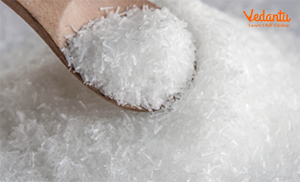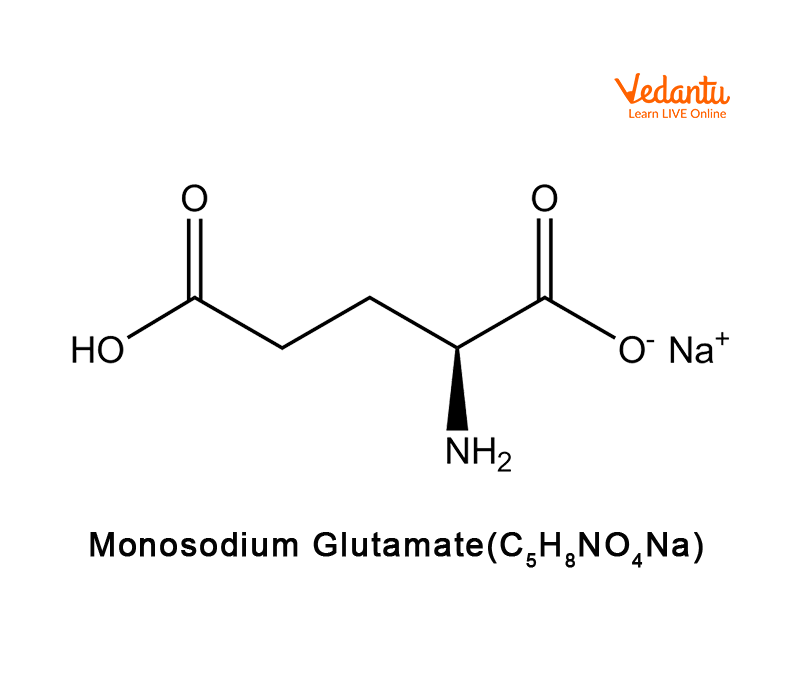




Why Monosodium Glutamate Is Important in Chemistry and Food Science
A popular seasoning and flavour booster, MSG, or monosodium glutamate, is the purest type of umami, the fifth style. Seasoner (monosodium glutamate) is widely intensified and enhances umami flavours in sauces, broths, soups, and lots of additional food.
Monosodium glutamate (MSG) is a flavour booster typically added to build flavours in food, canned vegetables, soups, meats, and alternative foods. The U.S. Food and Drug Administration (FDA) has classified monosodium glutamate as a food ingredient that is typically recognised as safe. However, this is still a debate whether MSG is good for health or not.

Monosodium Glutamate
What is Monosodium Glutamate?
MSG stands for Monosodium Glutamate. This can be a sort of glutamic acid, which is an organic compound that's present in various natural foods. Glutamic acid performs several functions within the body, like forming proteins.
The molecular formula and structure of monosodium glutamate are \[{{C}_{5}}{{H}_{8}}N{{O}_{4}}Na\]. MSG dissociates into Na cations \[\left( N{{a}^{+}} \right)\] and glutamate anions once \[\left( {{C}_{5}}{{H}_{8}}N{{O}_{4}}^{-} \right)\] dissolved in water. This compound was first made by the Japanese chemist Kikunae Ikeda in 1908. At room temperature, MSG exists as a crystalline solid that is white in colour. It doesn't have any distinct odour.

Molecular Structure of Monosodium Glutamate
Preparation of Monosodium Glutamate
Today, rather than extracting the chemical phenomenon of monosodium glutamate from seaweed broth, monosodium glutamate is created by the fermentation of starch, sugar beets, sugar cane, or molasses. This fermentation method is analogous to that accustomed to creating yoghurt, vinegar, and wine.
The flavouring (monosodium glutamate)or the ajino moto cluster is created through the fermentation of plant-based ingredients like sugar cane, sugar beets, cassava, or corn. Fermentation has been employed by humans for hundreds of years as a way to preserve foods and enhance their style. The preparation of monosodium glutamate is done by the following methods:
First, the sugarcane is extracted as glucose and sent to a fermentation tank, where fermentative microbes are then superimposed.
These microbes consume the glucose, releasing amino acid, which although neutralisation has become a solution that contains monosodium glutamate.
This solution is then decolourised and filtered, leading to a pure seasoner solution.
This pure mixture is crystallised via an evaporator and therefore the crystals are dried to provide the ultimate product—MSG.
Monosodium Glutamate Uses
Some folks in Japanese cultures consider monosodium glutamate, or umami, to be one of all 5 basic tastes. Several dishes featured in Japanese, Chinese, and South Asian cuisine use monosodium glutamate.
Some of the uses of MSG are as follows:
This compound is employed in many canned foods products and spice blends.
MSG is a vital element of many instant ramen noodle products.
MSG acts on the salt receptors and releases neurotransmitters.
The monosodium glutamate uses might facilitate food scientists to reduce Na content while not sacrificing flavours, additionally in inventing new, cost-efficient, reduced-salt products and menus that may encourage customers to form healthier decisions.
Physical Properties of MSG
MSG is used for the preparation of many food items. Some experts do not recommend the utilisation of monosodium glutamate in food because it will adversely affect their health or the development of children. Therefore, it's necessary to own an intensive understanding of compounds that are very popular and customary in our everyday lives.
Since we are discussing the properties of MSG, it's necessary to specify some distinctive physical properties of MSG. A number of physical properties of MSG are mentioned below:
It is a solid, white-coloured compound.
MSG is extremely soluble in water but not soluble in organic solvents. The solubility level of monosodium glutamate in water corresponds to 740 grams/L.
MSG has no odour or smell.
Its melting point is 232 oC.
Chemical Properties of MSG
There are many alternative properties of monosodium glutamate. A number of the chemical properties of MSG are as follows:
The IUPAC name for monosodium glutamate is sodium 2-aminopentanedioate.
The chemical formula is C5H8NO4Na.
The molecular mass of monosodium glutamate is 169.11 grams per mole.
The hydrogen ion concentration level (pH) of monosodium glutamate ranges from 6.7 to 7.2.
MSG can exist in zwitter ionic form, −OOC-CH(NH+3)-(CH2)2-COO−.
Interesting Facts
MSG is naturally occurring: Besides being added to food, monosodium glutamate occurs in nature. Tomatoes and cheeses contain natural monosodium glutamate.
More flavour, less Na: Monosodium glutamate contains solely 1/3 the quantity of sodium as salt. Also, monosodium glutamate amplifies and enhances the flavour of foods – whether it's occurring naturally or added to foods. The salt interacts with our taste buds, giving foods the umami, or savoury, flavour. So, if utilised in place of salt, monosodium glutamate may enhance the flavour of your food whereas reducing overall Na intake. This might facilitate managing blood pressure levels in people that are Na sensitive.
Conclusion
Monosodium glutamate which is also known as MSG or Ajino moto is quite popular for its taste and flavours. The preparation of MSG can be done by different methods. The most common method used for the preparation of MSG is the fermentation process.
Also, monosodium glutamate is used in various food items like ramen noodles. Besides its flavours, it has toxic effects also. It has been linked with obesity, Chinese Restaurant Syndrome, neurotoxic effects, and detrimental effects on the reproductive organs.
FAQs on Monosodium Glutamate: Complete Guide to Structure, Preparation & Uses
1. What exactly is Monosodium Glutamate (MSG)?
Monosodium Glutamate, commonly known as MSG, is the sodium salt of glutamic acid, a naturally occurring amino acid. It is widely used as a food additive and flavour enhancer. Its primary function is to impart a unique savoury taste known as 'umami', which is considered the fifth basic taste alongside sweet, sour, salty, and bitter.
2. What is the chemical formula and structure of Monosodium Glutamate?
The chemical formula for Monosodium Glutamate is C₅H₈NNaO₄. Structurally, it is a sodium salt derived from glutamic acid. The molecule consists of a glutamate ion (the conjugate base of glutamic acid) and a sodium ion (Na⁺). The glutamate ion has a carboxyl group and an amino group attached to a central carbon atom.
3. How is Monosodium Glutamate prepared on a commercial scale?
Commercially, MSG is produced through a fermentation process, which is similar to the method used for making vinegar or yogurt. The process typically involves:
- Starting with a carbohydrate source like starch from corn, sugar cane, or tapioca.
- Introducing specific bacteria (e.g., Corynebacterium glutamicum) that ferment the sugars.
- This fermentation converts the sugars into glutamic acid.
- The glutamic acid is then isolated, neutralised with sodium hydroxide to form the salt, and finally purified and crystallised into the final MSG product.
4. Why does MSG enhance the flavour of food? Explain the concept of 'umami'.
MSG enhances food flavour by activating specific taste receptors on the tongue that detect umami. Umami is the savoury, brothy, or meaty taste that creates a sensation of richness and fullness in the mouth. When MSG is added to food, the free glutamate ions bind to these receptors, intensifying the existing flavours and adding a layer of complexity and satisfaction. It doesn't just add its own taste; it balances and rounds out the perception of other tastes in the dish.
5. What are some examples of foods that naturally contain glutamate?
Glutamate, the key component of MSG, is found naturally in a variety of foods. The amount of free glutamate, which is responsible for the umami taste, is particularly high in:
- Tomatoes, especially when ripe
- Cheeses, such as Parmesan and Roquefort
- Mushrooms, particularly shiitake
- Seaweed (kombu)
- Fermented products like soy sauce and fish sauce
- Meats and broths
6. What is the main difference between Monosodium Glutamate (MSG) and common table salt?
While both are white crystalline solids used to flavour food, MSG and table salt are chemically distinct and have different effects on taste. The key differences are:
- Composition: Table salt is Sodium Chloride (NaCl), an inorganic compound. MSG is Monosodium Glutamate (C₅H₈NNaO₄), the sodium salt of an amino acid.
- Taste Profile: Salt provides a purely 'salty' taste. MSG provides an 'umami' or savoury taste.
- Sodium Content: MSG contains approximately 12% sodium by weight, which is about one-third the amount found in table salt (approx. 39% sodium).
7. Is the brand 'Ajinomoto' the same thing as MSG?
The name 'Ajinomoto' is often used interchangeably with MSG, but it is technically a brand name. Ajinomoto Co., Inc. was the first company to commercially produce and market MSG. The product sold under the Ajinomoto brand is a highly purified form of Monosodium Glutamate (typically >99% pure). Therefore, while Ajinomoto is a brand of MSG, not all MSG is produced by Ajinomoto.
8. What is the scientific view on the health effects of MSG and the so-called 'Chinese Restaurant Syndrome'?
The term 'Chinese Restaurant Syndrome' refers to anecdotal reports of symptoms like headaches, flushing, and sweating after consuming food with MSG. However, major international food safety bodies, including the U.S. FDA, have classified MSG as 'Generally Recognized As Safe' (GRAS). Decades of research and numerous double-blind, placebo-controlled studies have failed to establish a definitive link between MSG consumption and these symptoms in the general population. While a very small percentage of people may experience mild, transient sensitivity, the concept of a widespread syndrome is not supported by scientific evidence.
9. How can using MSG in cooking contribute to sodium reduction in a diet?
MSG can be a valuable tool for reducing overall sodium intake without sacrificing flavour. Because it contains only one-third the sodium of table salt and provides a powerful umami taste, it can make food seem saltier and more flavourful. By replacing a portion of the salt in a recipe with MSG, food manufacturers and cooks can reduce the total sodium content by up to 40% while maintaining or even enhancing the dish's overall palatability.
























